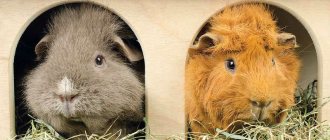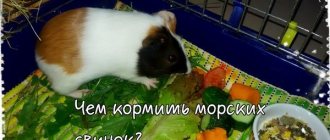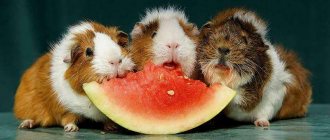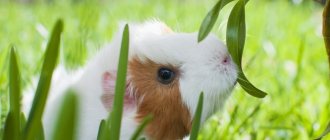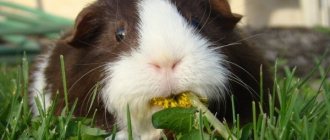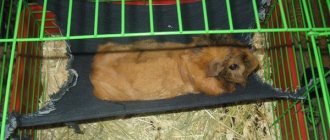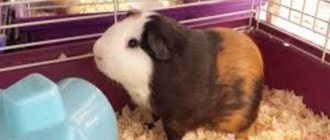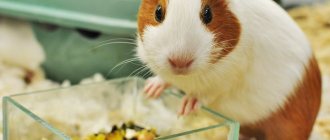Even though bell peppers are a source of ascorbic acid for guinea pigs, they should be given very carefully and not overdosed.
In general, according to many veterinarians, guinea pigs do not particularly need succulent food. For greens, it is better to give them lettuce, cabbage, carrot and beet tops.
If the owner has decided to introduce sweet peppers into his pet’s diet, then he should know that under no circumstances should this vegetable be given dirty.
Before the pepper gets into the animal's food bowl, it must be thoroughly washed, seeds removed and cut into small slices.
It is advisable to give this vegetable along with dry specialized food or seeds so that the pig alternates between different foods.
Future guinea pig breeders should know one more very important rule: even if the animal is given juicy foods, it should always have a bowl of fresh water in case the pet does not have enough fluid.
As for various seasonings, in particular red hot or allspice, such products are strictly forbidden to be given to rodents, since their stomachs may not be able to cope with food that is unusual for them.
The most interesting:
Is it possible to give chickens fish?
Breeding pets is a huge job that requires not only a lot of free time, but...
Can cats eat bread?
Pets have long been an inseparable part of people’s lives, because they are practically…
Is it possible to wet a cat in the heat?
Many people are accustomed to having their beloved pets as part of their daily lives. Beginning,…
You can give such food (food, feed)
Specialized dry food Hay twigs - willow, birch, linden, apple tree Carrots Zucchini Cabbage (white and in small quantities, as it can lead to excessive gas formation and related consequences). Beetroot Bell pepper Apples Pears (in small doses, as they are “heavy” food for the pig’s stomach) Berries Dill Parsley Celery Tops of carrots and beets Greens of sprouted wheat, oats and other grains Cucumbers (from your own greenhouse, since they are often poisoned because of the chemicals in purchased cucumbers, but even your own cucumbers should be given very rarely and in small quantities; cucumbers, due to their high moisture content, wash calcium from the body) Tomatoes (from your greenhouse because they are often poisoned), but not much. In the summer, grass is welcome (dandelions, sedge, clover, squash, plantains, etc.) Turnips Cauliflower Pumpkin Dried apples Corn grains (optional) Green strawberries, strawberries, raspberries - these are leaves Mint Currant leaves Young green peas in pods Peaches, apricots and nectarines (as a delicacy in small quantities, again due to the treatment of these fruits with chemicals) Plantain (do not forget to wash thoroughly) Rutabaga Leaf lettuce - in small quantities only the leaf, excluding leaf petioles if possible. Watercress - leaves in small quantities (can be whole) Head lettuce (in small quantities): oily (shaped like a head of cabbage, the leaf has a greasy sheen, contains many trace elements, nitrates accumulate mainly in the base and core) and Beijing or Chinese (an elongated head of cabbage, white at the base with green tips, it contains a lot of vitamin C, but also a large amount of nitrates in the base and lower parts of the leaf blade, can cause flatulence) - exclude, if possible, areas of lettuce containing nitrates.
You cannot give such food (food, feed)
Potatoes (in any form) Cereals (rice, buckwheat, millet) in any form, as a separate feed. Use “rolled oats” as the only, constant food Butter (in cereals, in its pure form) Animal proteins (milk, cream, cottage cheese) Watermelons (since now they are not stuffed with anything) Salty, sweet, fried Winter cucumbers, tomatoes, lettuce etc. It’s not advisable if it’s not made by yourself, as there are a lot of chemicals. Sugar Oak branches Citrus fruits (there is an opinion that oranges, tangerines, grapefruits can be given to pigs, but in very limited quantities, without peel (required!) and films) Eggs Meat Milk Fish Green onions Mushrooms Plums (strong laxative) Salad mustard Spinach Sorrel Burdock Sweet tea (I think tea in general) Salt (there are mineral stones for this) Marshmallow Marmalade Chocolate Flowers (all sorts) Chestnuts Horseradish Radish Garlic Crispbread (they contain salt and sugar, as well as other flavoring additives)
Vegetable menu
Vitamin C, which is responsible for the functioning of connective and bone tissues, pigs have to find outside because their body is not able to produce it without the help of others.
Guinea pigs love apples, cucumbers and carrots.
Ascorbic acid enters the body from plant foods, including new vegetables (broccoli, pepper ), amounting to more than 1 tea cup per day.
Among the vegetables that can be given to guinea pigs are:
- Zucchini. Rich in vitamins, minerals and pectins, which normalize digestive peristalsis.
- Carrot. It has a beneficial effect on the condition of the skin and coat, visual and auditory functions. In addition to root vegetables, it is allowed to feed tops. The contained beta-keratin (vitamin A) gives the urine an orange color.
- Bell pepper. Rich in vitamin C, but unsafe in winter due to the amount of harmful nitrates. Only sweet varieties are allowed as food, while spicy ones lead to irritation of the mucous membranes.
- Pumpkin. Not only the pulp is eaten, but also the crust and seeds, which contain zinc and act as a prophylactic against helminthiasis.
- Cucumbers. Low in calories, they have an anti-inflammatory effect and simplify the absorption of fats. Not suitable as a main food and unsafe in winter (high nitrates).
- Freshest peas. It is recommended to feed your pets only with the freshest pods, without overusing the quantity. Dried grains should not be consumed, but some manufacturers add them to ready-made food.
- Cabbage. Requests competent control. It is introduced evenly to avoid excessive gas formation. Rich in grey, which synthesizes collagen and adds shine to the coat.
- Swede. Helps with constipation, facilitating peristalsis, and has a diuretic effect. Involves consumption in winter, when the choice of vegetables becomes limited.
- Jerusalem artichoke. The consumption of root vegetables enriched with starches should be limited to avoid intestinal disorders. Other parts, rich in fiber and amino acids, are allowed on a constant basis.
- Tomatoes. In their greenish (immature) form they are considered poisonous due to solanine; consumption of the tops is also not recommended. Ripe tomatoes, containing a huge amount of vitamins, undergo destruction by unsafe poison, and therefore can be included in the diet in limited quantities. Beware of too much tomato, which can cause intestinal upset.
- Potato. Another vegetable rich in poisonous solanine and starchy substances.
- Melon. Unsafe for developing diabetes due to the richness of sugars.
- Radish and radish. Essential oils irritate the mucous membranes and cause bloating.
- Beetroot. Has a laxative effect. Not recommended during pregnancy, lactation and age Fruit menu
Fruits are rich in sugars, so they are not considered a real part of the diet, but only in the form of sweetness.
Among all the abundance of fruits, a guinea pig can only eat apples without serious restrictions. They normalize digestive processes and remove toxins. The seeds must be removed without fail because they contain poisonous toxins.
- Grapes. The richness of fiber and vitamin B has a positive effect on the body. Thanks to their pleasant taste, the animal eats the berries with great pleasure.
- Arbuzov. Only the pulp is fed to the animals. The crusts accumulate nitrites and are considered unsafe. Due to the diuretic effect, the amount eaten is kept to a minimum.
- Rowan trees. Chokeberry replenishes vitamins C and P, and reddish one replenishes carotene.
Controversial and unsafe berries and fruits include:
- Citrus. Irritate mucous membranes and provoke allergic reactions.
- Strawberries. It is fraught with an excess of vitamin C, leading to allergies, diarrhea, gastritis and ulcers. Given in small doses less than 1-2 times a week.
- Bananas. They replenish glucose and fiber, but due to the high calorie content and sugars, they are consumed to a minimum.
Fundamentally! When preparing your diet, keep in mind that sea mice are herbivores. Meat and dairy products are not digested by their bodies and pose a severe danger.
Nutrition Basics
In the wild, guinea pigs eat tree bark and branches, fruits, berries and leaves. The main material that ensures the smooth functioning of the digestive tract is fiber.
At home, the diet is based on:
Fundamentally! Hay created for gilts should be soft and greenish, and pelleted food should make up the smallest portion of the diet.
Rodents can be given less than 120 g of fruits and vegetables per day. Food is provided in small pieces and removed in case of malnutrition. Overripe or rotten foods will cause problems with digestion.
Grain feed
A guinea pig needs to eat at least 20% grain per day. Grain food for rodents is sold in any pet store. The finished product usually includes:
- barley; oats; millet; sunflower seeds; corn grains.
In addition to grain, prepared feeds may include vegetable granules and vitamin supplements.
Dry pet food is easy to prepare yourself; you just need to buy different types of grains on the market and then mix them. But you need to take into account that the main ingredient is oats; guinea pigs eat it more readily than other grains. Solid grain food should always be present in the diet of rodents. Animals need it to grind down their continuously growing teeth. If a rodent eats only raw and soft food, then its incisors become unnaturally elongated and interfere with the ability to absorb food. As a result, the animal dies from starvation.
What vegetables and fruits can you feed guinea pigs?
Herbivorous mammals love to feast on fruits and vegetables, but not all plant foods are equally beneficial for the body of mice.
Let's look at the basic principles of nutrition, and also look at the benefits and harms of vegetables and fruits that are acceptable in the diet of guinea pigs.
The nutrition of guinea pigs should be balanced and avoid hunger strikes. The lack of food left behind leads to rapid dehydration, depleting the body.
Vegetables and fruits, rich in vitamins and minerals, help restore water-salt balance and increase the resistance of the immune system.
Can guinea pigs eat zucchini?
Zucchini is suitable for the diet of guinea pigs. They contain small amounts of vitamin C, calcium and phosphorus. It is better to prefer young vegetables; they can be given together with the skin, cut into crowbars.
READ What rabbits can and cannot do
Purchased food
Some guinea pig owners, not wanting to rack their brains over a balanced diet, prefer to buy ready-made formulas. In theory, they are good because they contain all the necessary minerals and vitamins.
Alas, in practice it does not always work out this way. Often the package simply contains seeds and cereals that contain practically no vitamins. You can feed guinea pigs with such mixtures, but not for months, or regularly enrich the diet with additional food.
Other products
Can guinea pigs eat a loaf? It's better not to give.
The freshest yeast loaf takes a long time to digest and causes fermentation in the stomach of the beast. A snow-white loaf causes bloating. Your pet can eat stale loaf, but rarely. A dried loaf of seeds, sesame seeds and raisins can be offered to your pet as a sweet treat from time to time.
Can guinea pigs eat tomatoes?
Ripe fruits can be included in the food. Tomatoes are easily digestible by animals and contain vitamin C and carotene, which are beneficial for their body. Greenish tomatoes contain solanine, which can have a negative effect on your pet’s health.
A very large amount of tomatoes in an animal’s menu can cause watery stools.
Can guinea pigs eat nuts and seeds?
Nuts and seeds are among the permitted products, but can cause obesity if their consumption is not limited. It is better to offer your pet almonds, walnuts or hazelnuts.
The seeds contain many components necessary for the animal: fatty acids, calcium, sodium, phosphorus, proteins and vitamins. It is better to give peeled seeds and make sure that they are less than 15% of the total amount of feed.
What nuts are allowed to give to a rodent?
Opinions are divided regarding nuts. Some owners are of the opinion that this is an unnecessary product, because animals do not feed on them under natural conditions. Others consider the kernels to be an excellent treat, provided they are kept in moderation, but recommend offering them to mobile and active animals.
Whether guinea pigs need nuts in their diet is a controversial issue.
The kernels must also be raw. The most suitable nuts for guinea pigs are walnuts and hazelnuts. Many pets enjoy eating almonds. But there is an opinion that the dose of hydrocyanic acid contained in it may be toxic to the pet.
It is better not to consider pine nuts and peanuts as treats - these varieties contain too high a percentage of fat and can harm the health of the animal. If your pet is lazy and prefers to rest or sit in one place for most of the time, then it is better to exclude any types of nut kernels so as not to provoke obesity in the animal.
For useful information on whether it is possible to treat your pet with baked goods, read the article “Is it possible to give bread to guinea pigs?”
Is it possible to give a guinea pig nuts and seeds 5 (100%) 3 votes
What foods can you feed guinea pigs?
Even experienced livestock breeders ask questions: what to feed their pet, and whether it is possible to give certain products. Before getting a guinea pig, you should find out which foods will benefit the animal and which may harm its health. A guinea pig's daily menu should include vegetables, fruits, berries and cereals. Many vegetables and fruits can even be offered to your pet along with the skin. You should keep in mind that not all foods that guinea pigs eat are equally beneficial for them. What rodents can eat and what they cannot feed a guinea pig is discussed in this article.
Can guinea pigs eat cabbage?
Cabbage can be included in the animal's diet. Cabbage contains many vitamins and other substances that pigs need:
- ascorbic acid; B vitamins; vitamins of the PP group; folic acid; sulfur; calcium; potassium; phosphorus; amino acids; microelements.
The vegetable is able to maintain the animal’s fur in excellent condition and strengthen its immunity. The top dried leaves should be given. It is better to feed guinea pigs with Chinese cabbage and broccoli. White cabbage can cause bloating.
Can guinea pigs eat potatoes?
Greenish and sprouted potatoes are contraindicated for guinea pigs. Raw vegetables can be given from time to time by cutting them into small pieces. Boiled potatoes can be offered to your pet separately or added to cereals and other foods.
The vegetable contains solanine, which can harm the health of the animal if the pet eats a lot of potatoes. The pig will become passive and quickly catch a cold.
Useful tips
You need to gradually accustom your guinea pig to a new fruit. The best age for this comes after the cubs are weaned from their mother and have stopped feeding on her milk.
The surface of the fruit is covered with a shaggy skin. It was she who made him look like the flightless bird of Australia, the kiwi. It was on this continent that the first varietal fruits of Actinidia chinensis were obtained. The slightly fluffy skin does not allow the fruit to be washed thoroughly. It's better to remove it.
After this, the kiwi is cut in half and each half is cut into 3-4 pieces. Some representatives of the “pig” world do not prefer green pulp, but a slightly lighter center, which can be cut out and given separately.
If there is a choice in the retail chain, then it is better to choose yellow varieties, they are sweeter and may be liked by the rodent more.
Although kiwi is a healthy fruit, you shouldn’t indulge in it all year round. Imported fruits sometimes arrive unripe. They are not as soft and more sour. In this case, they can be left on the table for 5-6 days and they will ripen perfectly.
The fruits of its closest relative, actinidia, can also replace kiwi in the diet of pigs. This fruit-bearing vine grows everywhere in amateur gardens.
What else to include in a guinea pig's diet
A properly organized food regimen is very important for guinea pigs. A balanced and optimally selected diet is the key to good health, playfulness and a long life for pets.
All products that are used as food for these rodents can be divided into the following categories:
- roughage (hay and twig food);
- succulent food (vegetables, berries and fruits). Healthy and permitted foods include carrots, cucumbers, celery, green leafy salads, pumpkin, zucchini, tomatoes, apples, raspberries, kiwis, cherries (pitted);
- green food (greens and herbs). It is strictly forbidden to feed guinea pigs with herbs collected near highways, fields that are treated with chemicals against pests, and in places where pets are walked. You can treat the animal with the leaves of the following plants: dandelion, plantain, yarrow, nettle, peas, oats, sweet clover, alfalfa, dill, sage, parsley, tarragon. Many of them are spicy or contain essential oils in large quantities, so it is better to give them in doses;
- concentrates (multicomponent high-calorie feeds).
Guinea pigs breakfast HD1080
There are foods that are strictly forbidden to give to guinea pigs. Some items on this list are quite obvious, while others may be surprising.
Do not neglect these recommendations - this can be fraught with serious consequences for your pet:
- dairy and meat products;
- sugar or any sweets;
- flour products;
- corn;
- onions and garlic (neither tops nor root vegetables);
- radish;
- cabbage;
- eggs;
- raw beets;
- potato;
- avocado;
- rocket and iceberg lettuce;
- nuts;
- rhubarb;
- beans and peas (green shoots are ok);
- cereals or other snacks and breakfast cereals;
- canned or pickled foods.
Vitamin C is vital for your guinea pig and foods containing it should be consumed daily. Bell pepper can safely be called a record holder for ascorbic acid content. This means that a small piece of this juicy vegetable can satisfy your pet’s daily need for vitamin C.
Can guinea pigs have pepper?
Guinea pigs love fresh herbs and vegetables, including bell peppers. And, as a rule, as much as you put in their cage, they will eat as much. However, such overeating can cause serious harm to the health of this cute rodent. Therefore, treats should be given in doses. Bell pepper (100 g) contains 110 mg of ascorbic acid. Considering that other foods consumed by animals also contain vitamin C, but in smaller quantities, and the daily intake for a healthy animal should not exceed 16 milligrams per kilogram of weight, it is recommended to give no more than 25–30 g of pepper per day.
READ What can you feed your dwarf hamster at home?
Feeding regimen and technique
Healthy adult guinea pigs are fed twice a day, while pregnant guinea pigs and babies are fed up to four times a day. With two meals a day, rodents are offered succulent food for “breakfast,” and grain or a grain mixture and greens are prepared for “dinner.” In winter, greens are replaced (or supplemented) with hay.
It may be an unpleasant surprise for first-time owners to learn that pigs (even piglets!) eat their own feces. But this is how nature has established it: it is in this unusual way that colonies of beneficial bacteria enter the pig’s body. If you do not allow your pet and her cubs to eat your litter, this will immediately have a negative impact on the health of the animals.
Daily ration
Once the owner decides what to feed the guinea pig, he should pay attention to feeding standards.
Here is an approximate daily diet for an adult from the pig family:
Some veterinarians recommend feeding guinea pigs milk in the amount of 0.025 liters per day, regardless of season and age. Let us beg to differ with them. Rodents should not be accustomed to milk, because nature has not provided their body with enzymes that help digest dairy products.
You should be careful about your pet, because the given nutritional standards may vary depending on:
- degree of animal activity;
- health conditions;
- age.
So, pregnant females need more food. Therefore, the volume of food eaten for them increases by 30%.
Sorry, there are no surveys available at this time.
Fruits and vegetables
Fruits and vegetables are often also called juicy food.
What vegetables and fruits should and can be given to guinea pigs:
- Carrot;
- Apples;
- Cauliflower. Pigs really like the fresh green leaves of cauliflower, but pigs do not eat its white flowers.
- White cabbage. You should be careful when feeding white cabbage as it disrupts the intestinal flora of your pigs. For convenience, you should cut the cabbage leaves into pieces.
- Curly chicory, also known as endive (Cichorium endivia). It enjoys well-deserved respect, contains a lot of minerals and few carbohydrates, and is very watery.
- Celery;
- Citrus fruits;
- Green peas and beans (in very small quantities);
- Bell pepper;
- Brussels sprouts;
- Watermelon;
- Fodder beet;
- Red beets (or their greens);
- Cucumber;
- Ground pear (Helianthus tuberosus) - both leaves and tubers can be given;
- Corn cobs.
Even more information about succulent food for guinea pigs in the article “Succulent food”
can guinea pigs as treats.
What to feed pigs in winter. What kind of juice is possible?
Every living thing needs water, and so do guinea pigs, although there are some guinea pig breeders who claim that with the proper amount of greens, guinea pigs do not need water. This statement is erroneous and incorrect. In summer, pigs need plenty of drinking water, especially pregnant and lactating females.
Drinking water must be changed every day. It is advisable not to use a drinking mug, as the water in it spoils faster; it is better to use drinking bottles. But on very hot days, pigs can happily stand around an open drinking bowl and dip their front paws into it.
General feeding rules
Before you create a diet, you need to understand how to properly feed guinea pigs. Here you can give some simple and easy to implement tips.
- Try to feed your pet regularly at the same time. Animals get used to this quite quickly, manage to work up an appetite, thanks to which they eat all the food fresh and without residue.
- Regular pets should be fed twice a day - morning and evening. You should not give them any snacks - this will kill their appetite and harm their overall feeding regimen. But pregnant and lactating females need to be provided with four meals a day at approximately equal intervals.
- If any part of the food remains uneaten half an hour after feeding, it should be thrown away.
- Try to give fruits, vegetables and herbs only fresh - they contain more microelements and vitamins.
- Place hay and green food in a special feeder - do not allow the rodent to take them throughout the cage.
- Be sure to wash tomatoes, cucumbers and fruits before feeding, but do not need to peel them. But with sweet peppers it’s the opposite – here the thin film should be removed, because it is difficult to chew and can clog the guinea pig’s intestines.
As you can see, these rules are really simple - even a child can easily remember them. Strict compliance with these requirements will ensure excellent health for your pet.
When, how and what to feed guinea pigs
Proper nutrition, no matter how hackneyed it may sound, is the key to health, good mood and attractive appearance of a guinea pig of any breed.
But despite the abundance of information about the correct diet, there are still breeders (or members of their families) who are not averse to treating a pig with a loaf of bread, pouring seeds on it, or even offering it potatoes!
To begin with, it should be made clear once and for all that the guinea pig is a vegetarian, scientifically called a herbiphorus, which means “herbivore”, and has a relatively long digestive tract specially adapted for digesting coarse fibers. That is why it is important that pigs’ food contains a lot of plant fiber (fiber). Good hay and grass are a very important element in the diet, as they contain large amounts of fiber (fiber), which plays an important role in the digestive process.
Can guinea pigs have sweet peppers?
Guinea pigs love fresh herbs and vegetables, including bell peppers . And, as a rule, as much as you put in their cage, they will eat as much. However, such overeating can cause serious harm to the health of this cute rodent. Therefore, treats should be given in doses. Bell pepper (100 g) contains 110 mg of ascorbic acid. Considering that other foods consumed by animals also contain vitamin C, but in smaller quantities, and the daily intake for a healthy animal should not exceed 16 milligrams per kilogram of weight, it is recommended to give no more than 25–30 g of pepper per day.
Useful vitamins and other elements
The main composition of this vegetable includes water with a modified structure, which is very beneficial for the stomach and digestion.
Vitamins and the benefits they bring to the animal can be viewed in the table below:
| Vitamin | Benefit |
| Vitamin C | Supports immunity |
| Vitamin B9 | Fights anemia |
| Vitamin PP | Supports proper organ function |
| Vitamin H | Good for the nervous system |
| Vitamin B3 | Supports proper organ function |
| Vitamin B6 | Important for the immune and nervous system |
| Vitamin A | Helps improve vision |
| Vitamin B1 | Activates the work of all internal organs |
Did you know? These cute rodents get their name from the grunting sounds they make and their gluttony. They began to be called sea creatures, since the fluffies came to our country from overseas, from South America.
Table of minerals found in this product and their properties:
| Mineral | Benefit |
| Iron | Important for good blood |
| Potassium | Necessary for normal functioning of skeletal muscles |
| Phosphorus | Strengthens bones and teeth |
| Magnesium | Supports heart rhythms |
| Sodium | Important for the digestion and excretory system of the body |
What else to include in a guinea pig's diet
A properly organized food regimen is very important for guinea pigs. A balanced and optimally selected diet is the key to good health, playfulness and a long life for pets.
All products that are used as food for these rodents can be divided into the following categories:
- roughage (hay and twig food);
- succulent food (vegetables, berries and fruits). Healthy and permitted foods include carrots, cucumbers, celery, green leafy salads, pumpkin, zucchini, tomatoes, apples, raspberries, kiwis, cherries (pitted);
- green food (greens and herbs). It is strictly forbidden to feed guinea pigs with herbs collected near highways, fields that are treated with chemicals against pests, and in places where pets are walked. You can treat the animal with the leaves of the following plants: dandelion, plantain, yarrow, nettle, peas, oats, sweet clover, alfalfa, dill, sage, parsley, tarragon. Many of them are spicy or contain essential oils in large quantities, so it is better to give them in doses;
- concentrates (multicomponent high-calorie feeds).
There are foods that are strictly forbidden to give to guinea pigs. Some items on this list are quite obvious, while others may be surprising.
Do not neglect these recommendations - this can be fraught with serious consequences for your pet:
- dairy and meat products;
- sugar or any sweets;
- flour products;
- corn;
- onions and garlic (neither tops nor root vegetables);
- radish;
- cabbage;
- eggs;
- raw beets;
- potato;
- avocado;
- rocket and iceberg lettuce;
- nuts;
- rhubarb;
- beans and peas (green shoots are ok);
- cereals or other snacks and breakfast cereals;
- canned or pickled foods.
6 Healthy Foods for Your Guinea Pig
Vitamin C is vital for your guinea pig and foods containing it should be consumed daily. Bell pepper can safely be called a record holder for ascorbic acid content. This means that a small piece of this juicy vegetable can satisfy your pet’s daily need for vitamin C.
Pumpkin seeds for guinea pigs
Prohibited foods in the diet of a domestic guinea pig
If a guinea pig is fed properly and cared for well, it can live at home for up to eight years. Before introducing any product to your pet, you should make sure that it is not on the prohibited list.
Can guinea pigs have oranges and other citrus fruits?
Can be used occasionally. But it is better for guinea pigs to get vitamin C from other foods, avoiding citrus fruits. Possible complications:
- oversaturation with vitamins;
- skin irritation;
- oxidation of urine.
Can guinea pigs eat strawberries, grapes and other berries?
Strawberries contain a sufficient amount of vitamin C to pay attention to the berry when choosing a treat for a rodent. You can also give strawberry leaves to animals.
- The pig might like grapes. You can offer the animal seedless grapes.
- Eating currants once a week will also not harm your pet.
- If you do not abuse it, you can offer the pig berries and raspberry leaves, berries, leaves and branches of blueberries, blackberries and sea buckthorn, and rose hips without seeds.
- Cranberries are given for medicinal purposes. It has an anti-inflammatory effect on the mucous membranes of the mouth, stomach, and bladder.
READ What to feed a 3 month old toy terrier
Can guinea pigs eat apples?
Apples can be raw or dried. They have a balanced ratio of sugar and fructose (18:80%). It allows the pig to be active.
The fruit must be peeled and cut into slices. It is better not to give more than 3 pieces at a time.
Can guinea pigs eat a pear?
Pears can be given with the peel, but without the seeds. The fruit is washed well and cut into pieces; the pig should be offered water along with it. Excessive consumption of pears due to their high sugar content can cause diarrhea.
Can guinea pigs eat cucumber?
Cucumbers don't have as many nutrients as other vegetables. You can offer your pet a cucumber. The vegetable can harm your pet's health by causing digestive problems only if consumed in large quantities.
Can guinea pigs eat tomatoes?
Ripe fruits can be included in the food. Tomatoes are well absorbed by animals and contain vitamin C and carotene, which are beneficial for their body. Green tomatoes contain solanine, which can negatively affect your pet’s health.
Too many tomatoes in an animal's menu can cause loose stools.
Can guinea pigs have radishes?
It is permissible to use only radish tops. The root vegetable contains essential oils that can cause irritation to the mucous membranes and respiratory tract of the animal. The vegetable also causes bloating. Therefore, it is not recommended to give radishes to pigs.
Green feed
This food for guinea pigs is the most healthy and natural. Your pet should eat fresh greens, rich in fiber and nutrients, to maintain normal functioning of the intestinal tract. Below is a list of herbs recommended for guinea pigs:
- cereal sprouts; spinach; lettuce leaves; clover; carrot tops; beet tops; dill, parsley, cilantro; plantain; yarrow; chamomile; dandelion leaves.
You need to be very careful when collecting grass for your pet. Among the useful plants there may be poisonous ones. Therefore, you should not put a bunch of grass in a cage without carefully sorting it out first. Fresh greens for your guinea pig should be thoroughly washed.
The most important food for guinea pigs. Hay not only normalizes the functioning of the intestinal tract, but is also an excellent tool for grinding down the incisors of rodents. Like grain, hay is sold at any pet store. When purchasing, it is important to carefully check that the dried grass is not affected by mold. Rotten and moldy hay can harm your pet's body. If the owner is engaged in the preparation of hay on his own, then he must carefully inspect the collected grass for the presence of prickly, weeds, and poisonous plants.
What not to feed guinea pigs
There are a number of foods that should not be given to guinea pigs at all (for example, rhubarb or potato tops), and there are foods that, although they will not cause immediate irreparable harm to the pig, are still extremely undesirable for the diet of these animals.
Let's look at what is classified as “forbidden”.
So, guinea pigs should not be given:
Dairy products. milk, yogurt, cheese, etc. Guinea pigs are lactose intolerant because they do not have the enzyme to digest it. When dairy products enter the body, pigs develop gas and diarrhea.
Sweets, cookies, candies, marshmallows, marmalade. (Washing machine. point 5 about sugar)
Meat in any form. Guinea pigs are 100% vegetarian by nature, so don’t even try to treat your pet to a steak or cutlet.
Sugar. Any product containing sugar is harmful to guinea pigs, as even a small dose of sweets can cause an increase in blood sugar levels. The only exception. fresh fruits and berries that are good as a treat in limited doses (bananas, strawberries, watermelon, etc.)
Onions and garlic (and root vegetables and herbs)
loaf and any loaf-bakery products. These products, as a rule, contain an abundance of refined sugar, preservatives, improvers and other unhealthy ingredients, which, firstly, will be difficult for pigs to digest, and which, secondly, will cause certain damage to the pig's health.
Nuts. Nuts are very high in calories and fat. Feeding pigs this type of food can lead to obesity and heart problems. In addition, foods high in fat may contribute to the risk of atherosclerosis, liver damage and other diseases.
Beans (only green shoots are suitable for feeding)
Potatoes in any form. The starch contained in root vegetables poses a certain threat to pigs, and potato tops are simply poisonous.
Peas (only green pea shoots are suitable for feeding)
Cereals and other breakfast cereals. These are highly processed foods, contain sugar or sweeteners, a bunch of carbohydrates and not an ounce of benefit!
Grains and seeds. Here someone can argue: how can this be? After all, some pig food contains seeds, oats and other grains. Yes, grains and seeds are contained in feed, but only in the cheapest ones. And this does not mean that they are good for guinea pigs! Many seeds, for example, sunflower seeds, are very high in calories and contain a lot of fat. As with nuts, this can have a negative impact on the pig's health.
Any canned food. Any pickled or canned vegetables and fruits, including olives, etc. should be avoided. similar.
Special feed
Particular attention should be paid to the choice of purchased food for guinea pigs. Not all specialized mixtures presented in pet stores are suitable for these animals. When choosing food, you need to evaluate it according to the following criteria:
- Compound.
Herbal granules should predominate in it, other components should be kept to a minimum. Unshelled sunflower seeds can get stuck between teeth; corn is of no value to pigs; cereals are contraindicated, and cereals are too high in calories and are only suitable for animals that need to gain weight. - Granule size.
Granules found in chinchilla or guinea pig food are suitable. Formulas intended for rabbits and other larger animals usually contain large granules that are difficult for guinea pigs to eat. - Best before date.
Expired food can be harmful to animals and there is a risk of negative effects on the digestive system.
Below are examples of foods that meet all the criteria and are approved by professional breeders and ratologists:
is a complete, high-quality granular food for guinea pigs, containing a complex of essential vitamins. The composition additionally includes herbal additives that have a positive effect on digestion, and pressed cereals are completely excluded. The cost is 250-350 rubles for a package of 750 grams and 750–850 rubles for a package of 2.5 kg.
It is the most popular food; specialized mixtures for guinea pigs and universal mixtures intended for all rodents are suitable. The granules are made from 60 different herbs; cold pressing technology is used for their production, which allows you to preserve all the vitamins, minerals and beneficial chemical elements. The cost of a 750 g package is about 250–300 rubles.
Formulas intended for guinea pigs and chinchillas are suitable as they have a similar composition. The cost of one kilogram package varies from 150 to 350 rubles.
is a rather expensive food, but it has a high level of quality. The composition includes large granules containing the necessary fibers, allowing the mixture to be better absorbed. The cost of a kilogram package is 400–500 rubles.
"Animals"
is one of the few budget foods that is suitable for guinea pigs. It is necessary to purchase a mixture intended for chinchillas, since other varieties produced under this brand are too high in calories and can lead to obesity. The cost of packaging is 80–100 rubles.
What vegetables should you not give to guinea pigs?
Although most vegetables are safe and even healthy for pigs, in a separate paragraph we will consider the list of vegetables that pose a certain danger to pigs.
So, what vegetables should not be given to guinea pigs:
- onion,
- garlic,
- beans,
- peas,
- corn,
- beet,
- hot pepper ,
- potato,
- rhubarb
- avocado
Rhubarb and potatoes can be poisonous to guineas, but other vegetables cause digestion problems and, if given, should be given very rarely, or better avoided altogether!
And one more IMPORTANT RULE: all vegetables that the pig must be raw, not cooked!
Nutrition for pregnant pigs and newborn piglets
Pregnant pets must eat well and of high quality. The diet of furry mothers should be rich in proteins and vitamins. It is useful to give pregnant females carrots, beets, and wheat sprouts. You can periodically add a little milk to the water. Rosehip infusion brings great benefits to the body of a pregnant pig.
If the female who gave birth does not have milk, then the owner will have to feed the cubs on his own using a syringe. Artificial food for small piglets includes low-fat cream and the probiotic Linex. The cream is taken into the syringe and a tenth of the probiotic capsule is added to it. The resulting solution is nutritious and beneficial for the digestive system of babies. The food in the syringe is warmed to room temperature. Piglets take 1 ml of food every hour. Two-week-old babies can be switched to cereal porridge without milk. The piglets sit on the porridge until they get used to “adult” food.
animalsprotectionpetcare
Is it possible for a guinea pig?
From time to time, many, and especially beginner, breeders are faced with the question: “Is it possible for a guinea pig. ". and further according to circumstances. Meat, sweets, loaves, nuts, seeds, muesli.
Sources:
https://meowkiss.com/mozhno-li-morskim-svinkam-davat-krasnyj-perec/ https://moser-zoo.ru/kroliki-i-morskie-svinki/mozhno-li-morskim-svinkam-perets. html https://pets2.me/bok/gryzuny/morskie-svinki/pitanie-ms/2363-perec-v-racione-morskoy-svinki.html https://zoomservice.ru/kroliki-i-morskie-svinki/ tykvennye-semechki-morskim-svinkam.html https://svinki.ru/doc/%D0%BF%D0%B8%D1%82%D0%B0%D0%BD%D0%B8%D0%B5-%D0 %BC%D0%BE%D1%80%D1%81%D0%BA%D0%B8%D1%85-%D1%81%D0%B2%D0%B8%D0%BD%D0%BE%D0% BA/%D1%87%D0%B5%D0%BC-%D0%BD%D0%B5%D0%BB%D1%8C%D0%B7%D1%8F-%D0%BA%D0%BE%D1 %80%D0%BC%D0%B8%D1%82%D1%8C-%D0%BC%D0%BE%D1%80%D1%81%D0%BA%D0%B8%D1%85-%D1 %81%D0%B2%D0%B8%D0%BD%D0%BE%D0%BA/

